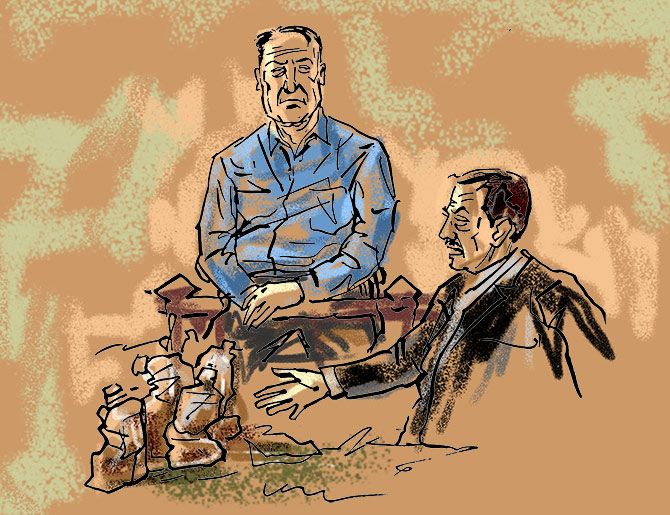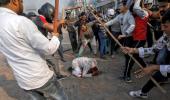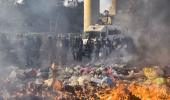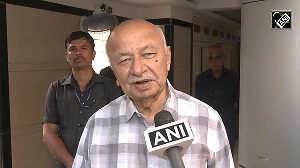Indrani dressed in a short purple kurta and leggings, with a bandhini green-purple chunni, sindhoor glowing in her mang, was receiving a drubbing from her lawyers for the facts she had revealed before the court on Tuesday while arguing the rejoinder to her bail application.
She was insisting: "But he asked me for a motive!"
Vaihayasi Pande Daniel reports from the Sheena Bora Murder Trial.
Illustration: Dominic Xavier/Rediff.com

On any weekday the Mumbai city civil and sessions court, located at Kala Ghoda, a hop, skip and a jump from the Jehangir art gallery and Elphinstone college, south Mumbai, is pretty packed out.
Throngs of people are always milling about.
The noise and the crowd, of course, ebbs and swells, depending on the time of day and the number of prison trucks growling their way into the courtyard below, to discharge dozens and dozens of accused.
Somewhere between 11 am and half past noon the number of relatives standing around the courtyard, as the sun beats down overhead, waiting for a loved one to arrive, from judicial custody, from jails as near as Arthur Road and Byculla jail, and as far as Taloja (44 km away), is at its highest.
This gathering of a humanity is naturally a microcosm of both Mumbai and India. A cross section of classes. The economically challenged. Plenty of middle-class people unexpectedly cogs caught in the wheels of justice. And the swish too, whose lawyers pull up in fancy cars.
All strata. All religions. All colours. All sexes, including the third gender. All professions. Different nationalities too.
But given that, of the people in judicial custody in India, 65 per cent are Dalits/scheduled tribes or OBCs, and 70 per cent are illiterate or semi-literate*, most of the people standing below are plain poor. And lack of financial means, above all, denies their jailed family member bail.
These poor might be living in the big city, or have come from rural areas to meet their undertrial relatives, but like it is in the slums, they bring a warm and charming village community kind of vibe with them.
The austere portals of the court are transformed by large joint families who hang around in knots all over the place. Grandmothers. Great uncles. Mothers in law. Clusters of women in ghungat or burqa. And lots and lot of children.
There can be sadness. Tears. Despair. Loneliness.
And longing.
But mostly, surprisingly, there is often a festive air, with relatives happy to meet up with their imprisoned usually male kin, bringing them food, little homemade goodies, probably photographs, sometimes clothes and loads and loads of love.
Adding to the merriment are the toddlers and children, in their Sunday best, running around playing games with themselves or their grannies/relatives -- simple games that involve hiding behind Sintex tanks, sifting the dust from the ground or fiddling with bits of twine discarded from some legal papers.
You wonder, with your suffocating middle class sense of propriety/values, about the advisability of bringing young children, with formative minds, to court and exposing them to the fact that their father, elder brother or uncle, or whatever, is in jail and to prisoners filing in, in handcuffs. And the occasional ugly moments, like spats with police escort.
But then, given the number of poor people in judicial custody, maybe it is a simple, practical fact of life, that these communities and families, including kids, have long since learned to live with, without any sense of embarrassment or guilt or stigma -- they are poor and so they are in jail, in judicial custody which does not mean they are guilty. A realism, we cannot understand.
Plus where would they leave their children every time they undertook the long, likely arduous and maybe expensive journey, by bus, train and on foot, to this court to see a relative.
Unlike the privileged trio of accused in the Sheena Bora murder trial, most undertrials, alas, seldom get out of jail on court visits, because of the paucity of police guards. A visit must be a big occasion for their folks and why should the littlest miss out?
Indrani Mukerjea's lawyer Sudeep Ratnambardutt Pasbola and CBI Special Judge Jayendra Chandrasen Jagdale were having a chat about just that the other day, in Courtroom 51.
They first spoke about the decline of crimes like extortion and, because of technology, the noticeable surge of white-collar crimes.
The judge then went onto say that every time he meets senior commissioners of police, he implores them to use some "common sense" while allotting guards and not send so many, presumably for this set of accused (Peter Mukerjea, Indrani Mukerjea and Sanjeev Khanna). And that one per accused was enough. Rather than five each.
Judge Jagdale: "Very difficult for them to run away!"
They both laughed.
They then discussed how rarely undertrials get a chance to make a trip to court and get outside jail.
And about the utter injustices and imbalances of that situation.
Prosecution Witness 66, Dr Rajinder Singh Dangi, 63, came to the stand on Thursday, February 27, 2020.
He was not new to these Mumbai courts. Pasbola seemed to have run into him quite a few times before and it looked like Dr Singh had made several appearances in court cases in his capacity.
No matter of surprise because he was the former head of the Central Forensic Science Laboratory, Lodhi road, central New Delhi.
Dr Singh started off, in a pedantic manner, reeling off, for ten minutes continuously, his many degrees, credentials and length of experience to the slightly startled court "MSc, BEd, MPhil and a PhD, 30 years of experience, 42 research papers etc, etc and 3,000 cases of various nature and inspected and recorded the scene of crime in more than 1,000 cases."
Post his retirement in May 2016 from the top post at CFSL, after a run of 16 years, he apparently taught at the Shree Guru Gobind Singh tricentenary university, Gurugram, and lived in Haryana.
A tall, lanky man, dressed in blue and black, with thinning hair that was untidily plastered to his head, a prominent nose, black glasses, Dr Singh was rather short on memory (beyond his own personal qualifications) and somewhat random about his methods and procedures.
As his testimony in chief proceeded, conducted by CBI Special Public Prosecutor Manoj Chaladan, there is always a tussle over pronunciation with this North-India-Dilli-log battery of witnesses.
Neither Mumbai lawyers, nor the judge or the prosecutor -- never mind the youthful, usually-hyper-efficient court stenographer Vaibhav -- are ever able to fathom what they are saying.
Each word gets questioned. Hence the judge's dictation for the court record sort of limps along painfully. "Swoil... Swoil?! Soil!... Suit... Suit? S-o-o-t... Soot!!"
And a bit of confusion always reigns.
Judge Jagdale irritatedly to Vaibhav: "As! Not 'ass'!"
Laughter.
And turning to Dr Singh and Chaladan he asked them to slow down -- "Very difficult for the typist to grapple!"
Clearly Mumbai wins hands down when it comes to English diction.
In October 2015 the Central Bureau of Investigation had approached Dr Singh for his assistance. He was asked to join the team of All India Institute of Medical Sciences forensic doctors who were visiting the crime scene in the sticks, a mango grove at Gagode Khurd, Raigad district, Maharashtra on October 15.
This was the place where Sheena's body had been found in May 2012, although Indrani told us, roundly, on Tuesday, making headlines Wednesday, that according to the verified Call Data Records, she was very much alive at the time.
Dr Singh hopped along with this gang to take some pictures, make some measurements and collect some samples.
The long and short of it was: He collected seven sets of samples. Some were soil. Some were pieces of wood (but not sticks/branches). And Exhibit 7 was, oddly, five plastic bottles without caps.
What the relevance of these bottles never got discovered on Thursday. They were standard mineral water bottles that litter many corners of India, unfortunately.
Are plastic bottles Dr Singh's signature crime scene sample? Something about the bottles tickled Pasbola and Gunjan Mangla, Indrani's lawyer, who looked at them and grinned.
The samples were sealed in Dr Singh's presence in 2015 and they all signed off on it. And a memorandum was prepared by the CBI that Dr Singh signed too.
He was unfamiliar with the contents of the memorandum and asked for a few minutes to read it, which lead to Judge Jagdale mildly ticking him off: "(Someone) in your position is supposed to read the document before signing. Without reading a document you are not supposed to sign."
Something about the way the 'testimony in chief' was unfolding irked the judge too, who is a stickler for procedure, and he told Chaladan: "Everything is short-cut, short cut!"
Dr Singh filed a three-page report on October 28, 2015 of his findings, after his visit to the spot of the crime.
The process of examining these seven samples in court was mildly tedious. And maybe slightly amusing for their contents, that did not seem highly conclusive or important.
Yellow manila paper envelopes emerged. Each envelope -- after the seals and signatures were examined -- produced either odd bits of blackened wood or lumps of "black/dark brown" soil.
Dr Singh, sitting relaxed, on his stool in the witness box, dictated the contents, one by one, strangely, scarcely looked at them -- "Parcel Two is a sealed yellow-coloured, brown (sic) envelope containing earth material/soil of dark brown colour in loose and lumps..."
And then came the envelope full of bottles, that were slightly blackened that had been wrapped in a cloth bag -- Parcel Seven is a sealed cloth parcel containing five plastic bottles in deformed/crushed condition (the pronunciation also in a crushed condition)..."
In his report, Dr Singh had made three conclusions -- Five of the exhibits including the soil and wood pieces "revealed the presence of blackened soot deposits which have caused due to burning of fire."
One packet of soil did not. And only one of the bottles "showed signs of burning effect, which had been carved due to burning of fire."
That was Dr Singh's testimony.
What all this meant the court was not told about. One was supposed to surmise that these were soil and wood pieces found near the scene of crime which showed signs of burning. But no additional details were provided.
Like crucially how far and where these samples had been collected from and what was the significance of any of it.
Where were the wood pieces from?
Whose bottles?
And why it had been so important to call Dr Singh in as part of the remaining 30 to 40 witnesses chosen from 189.
The court broke for lunch.
Judge Jagdale, who is also the guardian/mother hen of his flock of undertrials, called a puzzled Peter to the stand: "You want to eat sandwich, fruit and sweets? Sweets!? What kind of sweets?!"
Peter's sister, Shangon Das Gupta, who had brought the meal, volunteered, "Chocolates. Little chocolates."
Judge Jagdale smiling at her and Peter: "Dangerous (in your condition). You have diabetes."
Peter: "Not diabetes. I need for my low blood sugar."
Meanwhile, Indrani dressed in a short purple kurta and leggings, with a bandhini green-purple chunni, sindhoor glowing in her mang (parting), was receiving a drubbing from her lawyers for the facts she had revealed before the court on Tuesday while arguing the rejoinder to her bail application. She was insisting: "But he asked me for a motive!"
Post-lunch Pasbola, in a relaxed, easy-going mood, smoothly and effortlessly demolished Dr Singh through his cross-examination, in about 20 questions and 20 minutes flat -- literally had him for tea. The speed at which the lawyer did it, textbook-style, was breathtaking.
Maybe having most likely dealt with Dr Singh before, he knew what to ask or maybe he knew exactly where Dr Singh's memory would fail. And it did, on cue.
Pasbola: "Dr Rajinder Singh, when did you get intimation from the police to visit the (place of crime)? Date?"
Dr Singh: "From the CBI. Can I see (his file)?"
Pasbola, magnanimously: "Of course, of course! Can use your spectacles too, if you wish."
Dr Singh: "In this file there is no such letter."
Pasbola: "Nahin hai letter? Koiee baat nahin (Never mind)."
It was all miserably downhill from there with Dr Singh's answers being a monotonous, feeble series of "I do not recollect"s, "I do not know"s and "I do not remember"s.
He could not name who in the CBI had contacted him and how many days before his visit to Raigad. He remembered only one of the AIIMS doctors who had been there that day, but not if PW 61 Dr Sudhir Gupta of the AIIMS forensic department had visited (he had not). He did not remember who had pointed out the spot to him. Or anything about the spot.
Pasbola: "Did you take any measurements? Did you take any photographs?"
Dr Singh nodded.
But he didn't have either the photographs or the measurements or remember where he recorded the measurements or the distance from where he collected the bottles. Or recall additional facts about the site, be it flora or fauna, signs or other objects around.
He was blank, like a white board or a clean slate, or a history student sitting down, by mistake, to a calculus exam paper.
Pasbola strayed fleetingly into the mysterious domain of chemistry, although he cried off knowing much, since he had studied science till only his school graduation. But he and Dr Singh companionably exchanged dialogues on the "irreversible nature" of burning as a chemical reaction.
Pasbola: "Fire itself is a phenomenon that can be manmade, accidental or natural?"
Dr Singh agreed.
Finally, Pasbola: "Looking at the articles one cannot say when they were burnt?" He asked about the bottles too (Dr Singh did not if they had been sent for chemical testing).
Dr Singh: "No. Not the exact timing of burning. Cannot say exact period."
The cross-examination came to a mercifully quick close and the heaps of "blackened" soil and mineral water bottles were given their marching orders too.
The next witness is a handwriting expert on March 7.
And then Chaladan announced, without any fanfare, in his casual, quiet style, Rahul Mukerjea, Sheena's boyfriend and Peter's younger son from his earlier marriage, would be summoned from Dehra Dun.
That should be quite change, for this courtroom, and case. After a whole season of examining plastic bottles, wood chunks, kid's morphing software, incomplete credit card records, hand-adjusted DNA graphs and too-zealous or too-accidental panchas.
After waiting months in this trial for the real tale behind this strange, unfathomable murder, that has piqued India's collective curiosity for five long years, Rahul Mukerjea is finally scheduled to arrive.
*As per a 2016-2017 National Crime Records Bureau statistics, quoted in India Today magazine.
Vaihayasi Pande Daniel covers the Sheena Bora Murder Trial for Rediff.com.
You can read her fine coverage here.











 © 2025
© 2025